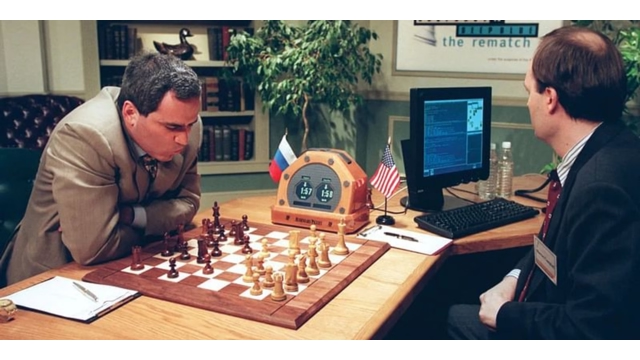- Blogs
- Giant Leap Forward
Giant Leap Forward

Wajeeh Ullah
Homo sapiens have covered unimaginable distances in exploration, science, and technological advancements. This can be understood best in the words of Neil Armstrong when he set foot on the moon. It was truly a “giant leap forward,” as humanity had covered a long distance, from igniting fire with rocks to fueling rockets that carried astronauts to that celestial body that had fascinated every generation of ancient men.
According to an article published in the Economist magazine, before the 1700s, the traditional world economy grew 8% per year. Still, after the Industrial Revolution, growth rates skyrocketed, reaching up to 350%. It was all due to free thinking, novel scientific ideas, and human willingness to achieve the technological milestone.
Three years before the end of the millennium, a chess competition was conducted in New York City. This chess match was about to make history. On one side was the wizard grandmaster of chess, Garry Kasparov from Azerbaijan, and on the other hand was IBM's Deep Blue supercomputer. It took IBM 40 years of relentless hard work and laser focus to make a machine that could challenge human intelligence. IBM chose chess as it was a game of skilful memorisation and strategic, methodical thinking. The competition kicked off with Kasparov dominating by winning one match. But to his surprise, Deep Blue won the other two, and the remaining three ended in a draw. The results were astonishing and jaw-dropping. For the first time in history, some technology had outsmarted its master.
Now, fast-forward to 2025, and we not only see Google’s AI marvel Gemini Deep Think participating in the International Mathematical Olympiad but also correctly answering five out of six complicated mathematical equations based on Algebra, Geometry, Number theory, and combinatorics.
Gemini Deep Think was awarded a prestigious gold medal for its achievement, the highest honour a mathematician can dream of while playing the Olympiad. These examples show the progress of AI learning models in the past two decades. IBM's Deep Blue was a simpler supercomputer designed to memorise chess positions. It processed 200 million chess positions in one second. The model was based on deterministic principles of learning.
On the other hand, Google’s Deep Mind Gemini project uses novel reinforcement and parallel thinking techniques. The learning software is programmed to use multiple methods to solve each problem and automatically learn through trial-and-error reasoning. The progression is not a miracle, but a systematic and tireless advancement fueled by immense capital, human supervision, and endless teamwork.
This is the age of AI. This coming-of-age technology has digitised every piece of information humanity has ever produced. Technological advancements made by AI are jaw-dropping in every field of knowledge. It has managed to transform the entire thinking patterns of humanity. To understand how much AI knows about various forms of human knowledge, a group of researchers asked forecast groups and biologists to guess when AI will be able to replace human virologists. Biologists marked 2030 and Forecast group members marked 2034 as the time when AI will be able enough. But to their surprise, OpenAI’s o3 model was already working on that level in 2025. Moreover, makers of AI labs are pouring enormous amounts of money into the business. Open AI’s CEO, Sam Altman, announced a $500 billion investment solely in America. Meta is trading machine learning engineers and poaching them with huge salaries. The race to dominate AI is becoming expensive day by day.
AI has proven to be a source of amusement for Gen Z. They enjoy what AI offers in Digital creation, entertainment and educational learning. However, the grass is not always greener on the other side. Geoffrey Hinton, winner of the 2025 Nobel Prize in Physics, has clearly stated that there is a 10-20% chance that AI can end up in human extinction. Now the claim is not from a random source, but from the pioneers of machine learning programs. Sam Altman recently warned that AI can threaten national security if malicious groups control it.
Shane Legg, building Google’s Deep Mind AI lab, recently addressed how AI can harm human civilisation. He noted four main ways that AI could do wrong to the humanity. We will stick here with only one factor, which is Misalignment. The prospect that AI could go against its makers. One of the chief attributes of today’s learning programs is their ability to multiply their information and handle all the necessary operations by themselves. The time is not far when they will become so powerful due to this automation that they could mistakenly or by strategy form alliances with such groups who have a nihilistic approach to the future. It could be a false alarm, but AI can access every data centre worldwide.
In a nutshell, the age of AI is the pinnacle of human progress and development. We cannot stop the process, nor should we. What we can do is to learn more about it and look at the bright side of technological advancements.
Disclaimer: The views expressed in this article are solely those of the author and do not necessarily reflect the official stance of The Himalayan Research Institute Pakistan - (THRIP)
_________________________________
Wajeeh Ullah is a student of BS Political Science at Government College University Lahore.
Contact us

Write with Us
The Himalayan Research Institute is proud to introduce "Himalayan," a dynamic and insightful magazin...
- [email protected]
- +923426470466
- website
